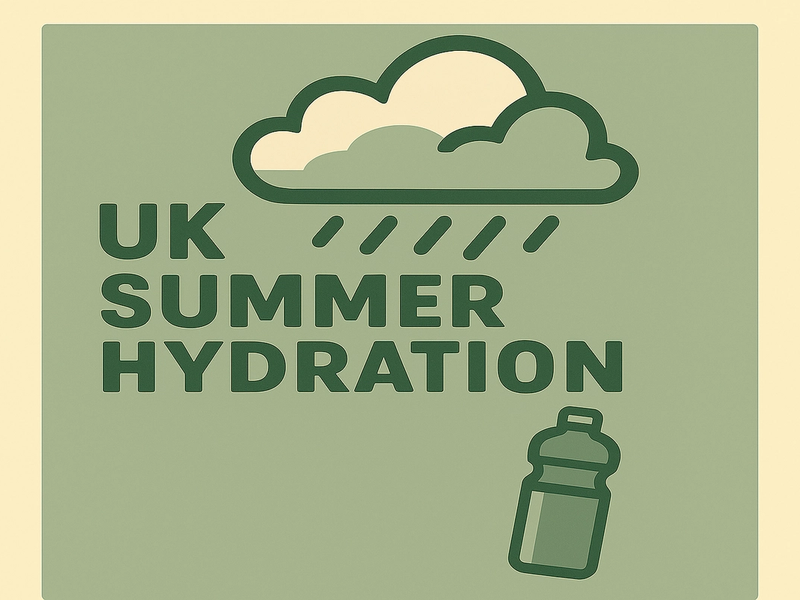Summer Hydration - Calculate Your Needs
6/26/2025

Even in the UK’s moderate climate, proper hydration becomes crucial during summer months, especially for longer runs or during those occasional warm spells. Understanding your individual hydration needs through simple testing can significantly improve your performance and comfort, regardless of whether you’re running in 15°C drizzle or a rare 25°C sunny day.
Sweat Rate Testing at Home
Your sweat rate varies significantly based on temperature, humidity, effort level, and individual physiology. Even in cooler UK conditions, you’re losing more fluid than you might realise, and understanding your baseline helps you prepare for both typical British summer conditions and those occasional hot days.
Basic Sweat Rate Test Protocol
1. Weigh yourself nude immediately before running (to nearest 0.1 kg)
2. Record all fluid intake during the run
3. Weigh yourself nude immediately after running, before drinking anything
4. Calculate: (Pre-weight - Post-weight + Fluid intake) ÷ Exercise duration = Sweat rate
Example Calculation
- Pre-run weight: 68.0 kg
- Post-run weight: 67.3 kg
- Fluid consumed: 500ml (0.5 kg)
- Run duration: 60 minutes
- Sweat rate: (68.0 - 67.3 + 0.5) ÷ 1 = 1.2 kg/hour or 1.2 litres/hour
Even in typical UK summer conditions (15-20°C), many runners lose 0.8-1.5 litres per hour. On those rare hot days (25°C+), this can increase to 2+ litres per hour. Testing in various conditions helps you understand your range.
UK-Specific Testing Considerations
- Test in typical cool conditions (15-18°C) to establish your baseline
- Test during humid conditions (common in UK summers) as this affects sweat rate
- Test on warmer days (20°C+) to prepare for heat waves
- Account for wind effects, headwinds and crosswinds can increase sweat rate
- Consider testing with and without waterproofs as this affects heat retention
Electrolyte Replacement Formulas
UK runners often underestimate electrolyte losses, assuming that only hot-weather runners need to worry about salt replacement. However, longer runs in any conditions deplete electrolytes, and UK humidity can increase losses more than expected.
Average Electrolyte Losses per Litre of Sweat
- Sodium: 400-700mg (varies significantly between individuals)
- Chloride: 500-1200mg
- Potassium: 150-300mg
- Magnesium: 10-40mg
Calculating Your Sodium Needs
1. Determine your sweat rate in litres per hour from testing
2. Multiply by estimated sodium concentration (start with 500mg/L)
3. Target replacing 50-80% during exercise, remainder post-exercise
Example:
- Sweat rate in typical conditions: 1.0 L/hour
- Estimated sodium loss: 1.0 × 500mg = 500mg/hour
- Target replacement during exercise: 250-400mg/hour
Practical Replacement Options:
- Sports drinks: typically 100-200mg sodium per 250ml
- Electrolyte tablets: usually 200-500mg per tablet
- Natural options: banana with pinch of salt, salted nuts
- Emergency option: small pinch of table salt in water bottle
Signs You Need More Electrolytes:
- Muscle cramping (especially in calves or hamstrings)
- Feeling weak despite adequate hydration
- Persistent thirst even after drinking
- Headaches during or after longer runs
- Unusual fatigue that doesn’t match effort level
Hydration Timing for UK Conditions
UK summer hydration strategy must account for variable conditions and the tendency to underestimate fluid needs in moderate temperatures. The key is consistency rather than dramatic adjustments.
Runs Under 60 Minutes (Typical UK Conditions):
Pre-hydration is usually sufficient. Drink 400-500ml of fluid 2-3 hours before running, then 150-200ml 15-30 minutes before starting. During the run, small sips if thirsty, but don’t force fluid intake.
Runs 60-90 Minutes:
Begin structured hydration during exercise. Target 150-200ml every 15-20 minutes, adjusting based on conditions and thirst. In typical UK conditions, water is sufficient for the first hour, then consider electrolyte replacement.
Runs 90+ Minutes:
Implement comprehensive hydration strategy. Target 80-90% of sweat rate replacement when practical. Include 200-300mg sodium per hour after the first hour. Consider alternating water and electrolyte drinks.
Weather Adjustments:
- Cool, wet conditions: Reduce intake by 10-20% but maintain electrolyte focus
- Humid conditions (common in UK): Increase intake by 20-30%
- Windy conditions: Increase intake slightly due to additional cooling demands
- Rare hot days (25°C+): Increase intake by 40-50% and emphasise electrolytes
Practical Hydration Tips:
- Many UK running routes pass pubs, cafes, or shops, plan these as hydration stops
- Public water fountains are common in parks and town centers
- Carry backup hydration for remote areas like moors or coastal paths
- Consider the weight of carrying fluids for long fell runs
Post-Run Recovery:
Replace 150% of fluid losses over the following 4-6 hours. Include sodium with rehydration fluids to enhance retention. In UK conditions, this often means 1.5-2 litres over several hours after long runs.
Monitoring Success:
- Urine colour: pale yellow indicates good hydration
- Morning weight: should return to normal within 24 hours
- Energy levels: proper hydration supports consistent energy
- Performance: well-hydrated runners maintain pace better in final stages
Individual Optimization for Runners:
Track your hydration strategy across different conditions:
- Cool, dry days (common in spring/autumn)
- Cool, wet days (frequent in summers)
- Humid, muggy days (occasional summer occurrences)
- Rare hot days (increasing with climate change)
Remember that UK weather can change during a single run. Start with your baseline hydration strategy but be prepared to adjust based on changing conditions. Carrying slightly more fluid than you think you’ll need provides flexibility for unexpected weather changes or longer-than-planned routes.
Your hydration needs will also change as you become more acclimatised to UK summer conditions and as your fitness improves. Regular testing and adjustment ensure your strategy remains effective throughout the summer training season.